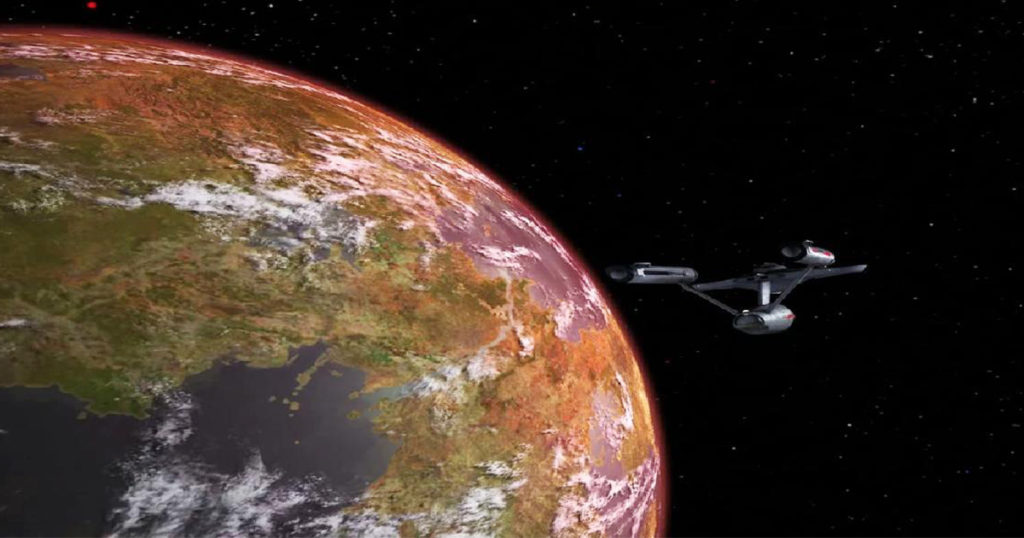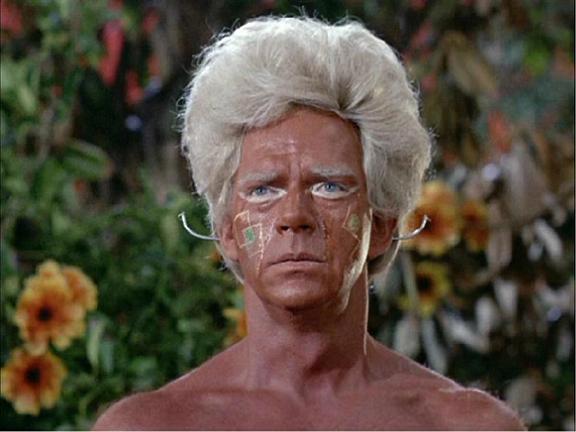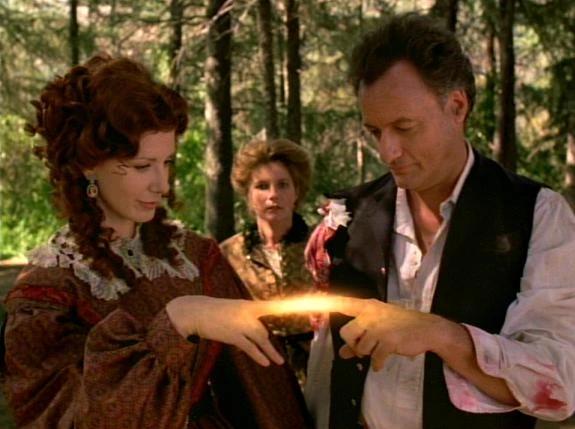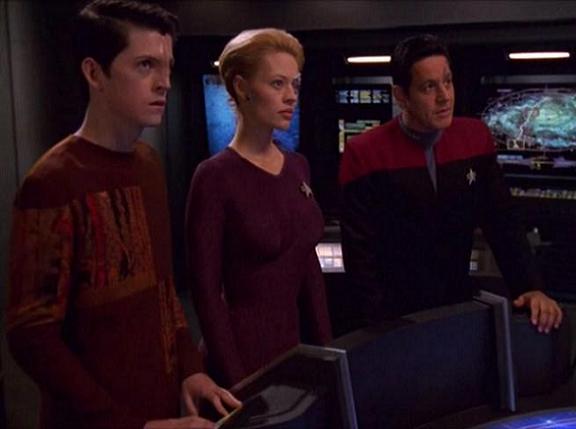
Apparently, everyone in the universe is sexual. At least, this is what Star Trek seems to tell us, since almost every person, race, android, and hologram we see throughout Star Trek is either inherently sexual or is marginalized for not being so. But does it have to be that way? In a franchise exploring infinite diversity in infinite combinations, it’s sad to realize that diversity apparently doesn’t extend to legitimately exploring a lack of sexuality – something we don’t have to search for just in space, but can find here on Earth.
A lack of sexual attraction is described, in broadest terms, as asexuality. As an asexual person myself, I know firsthand that asexuals are often lambasted as cold and unfeeling, or prudish, childish, and awkward – and that these labels are often internalized. Media is a valuable tool in breaking stereotypes like these, but unfortunately asexuality is rarely represented in media, or represented inaccurately. This becomes especially disheartening when we look at franchises like Star Trek that could potentially explore asexuality in creative ways that push our understanding of human relationships.
There are many times Star Trek could have explored asexuality – if not in name, certainly in theme – but either chose not to or misrepresented it entirely. As each series introduces new civilizations, it would be nice to see some of them be inherently asexual and treated with validation. But often it’s seen as hair-raising, such as in TOS’s “The Apple,” featuring the non-sexual Vaalians. The episode links the Vaalians’ lack of sexuality to the other elements of their society that have caused them to stagnate, furthering the idea that a lack of sexuality is abnormal, even crippling.
To the episode’s credit, it does allow Spock to argue that, just because the Vaalian society is not what humans expect, does not make it invalid. Unfortunately, this argument is stripped away when the Vaalians become violent on their god Vaal’s orders and attempt to kill the crew, proving that Vaal is keeping the Vaalians in pseudo-slavery. Eventually, Kirk is forced to destroy Vaal, but when the people express concern about how they will survive now, Kirk reassures them they will now be able to lead “normal” lives, as in, ones that involve sex. He promises “You’ll learn something about men and women – the way they’re supposed to be. […] That’s what we call … love. You’ll like that, too,” again implying that sex and romance are essential parts of everyone’s lives.

Akuta, leader of the Vaalians, actually cries when Kirk hits him, playing into the whole “non-sexual = childish” trope and aiding the impression that non-sexual people are children who don’t have the knowledge to make calls about their own sexuality.
The entire end of the episode is portrayed as hilarious, which makes it more troubling – it’s jarring to see the Enterprise crew “fix” the Vaalians and laugh about it, especially when “fixing” asexuality is a very real misconception with very real consequences. Since asexuality is an orientation that still struggles for visibility, it is often very hard for people who are beginning to come to terms with their identity to feel like they are valid. Often times, their lack of sexual desire is seen by their peers much like it is seen by the Enterprise crew in this episode – as a bizarre, fictitious thing that is not to be taken seriously, or worse as a thing that can easily be “fixed” as if you are flipping a switch.
The idea that asexual people are broken is something that many asexuals hear, feel, and internalize on a daily basis (myself included for many years). The assumption that asexual people just need to experience sex in order to be “normal” also has darker consequences than the humor of “The Apple” would have you believe, consequences that no one in the episode – besides Spock – sees fit to address. Of course, we never visit the Vaalians again, and are left to assume everything’s fine now that they are free to live “normal” lives. It feels as if the episode is attempting to define humanity in entirely sexual terms and by extension define all life in sexual terms as well. This may have been a progressive, important message in 1967, but for a show that’s supposed to challenge conventional ways of defining life, it’s disappointing.
This type of asexual denial is not just present in TOS, but a current of it runs throughout Star Trek. For instance, it is difficult to find any species in the universe that can be described as inherently asexual that are respected as valid lifeforms. Most non-sexual species are portrayed as sexually repressed or vaguely nefarious. Even species that don’t specifically have sex (like the Q) still have mating rituals that are used as sexual stand-ins. Trying to find individuals who can be called asexual is even harder. When you do find someone, usually they’re not entirely human, and sex and romance are portrayed as things they must go through to fully gain humanity.

Although the Q mating ritual in “The Q and the Grey” is literally just touching fingertips, the act is used as a sexual stand-in and played for laughs, particularly when Q declares “I was good, wasn’t I?”
This is perhaps best seen in Seven of Nine’s quest to explore her humanity. Over four seasons, she builds meaningful friendships, but these are treated as less important than romance. There is nothing wrong with Seven choosing to pursue a romantic or sexual relationship, but the problem lies in the reactions of those around her, who often express relief that she is embracing these relationships.
Sometimes it also seems like the Voyager crew is pressuring Seven to enter into relationships even when she is hesitant. In “Unimatrix Zero” – in which Seven rediscovers a previous romance with a man named Axum – the crew’s insistence that Seven go be friendly with Axum feels uncomfortably familiar from an asexual perspective, as if the crew doesn’t believe Seven when she wants to pull back. The entire thing is played up as if Seven is suppressing her desires and that her friends must help her see the light – which again many asexual people will recognize and which feels similar to the “fixing” of the Vaalians.
Worse is “Human Error,” in which Seven obsessively practices romance on the holodeck. This episode makes it seem like Seven can only truly attain her humanity if she also attains a relationship. Furthermore, “Human Error” tells us that Seven’s cortical node is designed to shut down at a certain level of emotional stimulation. But apparently the Borg are only interested in the influence romantic and/or sexual love might have on their drones, since the node has never shut down before. During the episode, even The Doctor proudly declares that Seven is ready for “deeper relationships,” implying that sex and romance are the pinnacle.

Apparently, Seven’s cortical node is designed to shut down only when sex and romance are attained – otherwise I would say that her tears at seeing Icheb alive at the end of “Imperfection” should have probably been enough “emotional stimulation” to shut the node down long before the events of “Human Error.”
It’s hard to see a character like Seven of Nine, someone I personally identify with, be pushed into “normalizing” romantic or sexual situations. It’s likewise demoralizing when you hope to find yourself represented through an alien race but instead find only a dozen canon non-sexual races in the universe. But if Star Trek has taught me anything, it’s to hope. The continuing mission of my first fandom is far from over and as long as new Star Trek content continues to be made, I will continue to hope I can one day see myself represented. It’s been fifty years since we were first invited to explore strange new worlds – I hope one of those worlds will one day have people like me on it.
I understand what you are saying, and I really feel like it could apply to so many other lost opportunities with engaging and learning about alien culture. Like, cultural norms that we have – that are social constructs – are just a given. Anytime there is a soldier, it is a man. Other planets have seedy bars where women are bought who are attractive by western standards. There is so much room to explore! Ad challenge! Why not?
Thank you all so much for the sweet and insightful comments!! Reading them has meant the world to me and I’m so pleased to hear you enjoyed the post. I am very thankful I got the chance to discuss a subject so personally important to me in the context of something so dear to my heart. Remember that none of us are alone! 🙂
This was a great article!! Always happy to see asexuality get some attention! And reading the comments both here and on the Facebook page is so nice because it makes me remember again that I’m not alone! So thank you!
What about “In Theory” with Data trying out a relationship even though he doesn’t have romantic feelings for the girl?
An interesting episode to add to the discussion, but I think it’s slightly different. Aromantic (lack of romantic attraction) and Asexual (lack of sexual attraction) are not the same thing. Some people are AroAce, but not all aromantic people are asexual and not all “aces” are aromantic (like me!). While we mostly consider ourselves the “Aro/Ace” community, there is an important distinction.
But yes, exploring “In Theory” – or any of Data’s “relationships,” really – from an Aro perspective would be very interesting!
Thanks for explaining! I don’t know anything about asexuality, I would like to learn more. Why do you think that Data is sexually attracted and not romantically attracted to her? I got the impression both aspects were just part of the experiment.
From one asexual Trekkie to another, I can’t thank you enough for this post. Until such a time as we get to see ourselves on screen, discourse like this helps me feel less alone.